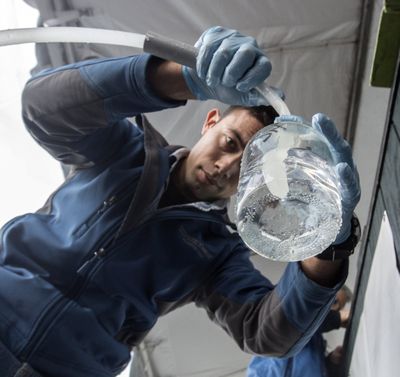Ocean XPrize teams try for cash, solutions
Contenders vying for prize test pH sensors in Sound water

SEATTLE – There’s a new tank at the Seattle Aquarium, but it’s not populated by sea creatures.
Tucked out of public view on an open-air dock, the tank contains an array of metal cylinders and gadgets suspended by wires in water circulating from Puget Sound.
The devices represent the hopes of 14 teams from around the world competing to build better ocean pH sensors – and take home $2 million in prize money.
It’s part of the latest initiative from the XPrize Foundation, best known for its attempts to revitalize space travel.
One of the biggest threats to the world’s oceans is chemical changes that occur when carbon dioxide from power plants, cars and other human activity dissolves in the water, making it more acidic, said Paul Bunje, director of the Ocean Health XPrize competition.
But measuring those changes is challenging, and existing instruments are expensive and temperamental.
So the Ocean XPrize was launched to catalyze development of cheaper and more reliable alternatives. Out of a field of 77 entrants, the teams that made the first cut subjected their designs to a round of laboratory shakedowns in California. Beginning Feb. 7, the remaining 14 contestant groups carted their gear to Seattle for a monthlong test to determine how well the sensors perform in the fluctuating conditions of Puget Sound.
“Washington is really ground zero for ocean-acidification research and response,” Bunje said.
Seattle-based scientists were among the first to study the phenomenon. Oyster growers on the Washington coast were among the first to feel its effects when a spike in acidity started killing larvae in hatcheries.
Since the start of the industrial age, the average pH at the ocean surface has dropped from 8.2 to 8.1, said Chris Sabine, director of the National Oceanic and Atmospheric Administration’s Pacific Marine Environmental Laboratory in Seattle and a technical adviser for the competition. That doesn’t sound like much, but it translates into a 30 percent increase in acidity. The trend is expected to intensify in the coming years as oceans absorb more CO2.
No one knows what the impact will be on marine life, but scientists have already documented damage to tiny, shelled creatures at the base of the food chain. Some commercially important species, like crab, may also be vulnerable.
It’s difficult to track subtle shifts over long periods of time – and across a wide range of ocean conditions and depths. Instruments that can do the job cost $20,000 to $30,000 and require constant upkeep.
“The idea behind the XPrize is that if we can get a very accurate, robust sensor that is much less expensive, then we can give them to everybody,” Sabine said. “People walking down the beach could stick their sensors in the ocean and type the results into a Web page.”
In that spirit, one of the teams designed its instrument to fit in the fin of a surfboard. Another team is made up of a group of teenagers from Carmel, California, managed by the mother of three team members. William Barrow, from Cambridge, England, works for the oil- and gas-industry giant Schlumberger, but he and his partners cobbled together their entry at the last minute, in their free time.
Throughout the Seattle tests, NOAA biologist Remy Okazaki – whose salary is being paid by the XPrize Foundation – will use the current gold-standard technology to regularly measure the pH of the water being pumped through the tank. That data will be used as the yardstick against which to measure the performance of the 17 instruments on trial.
After Seattle, the next stop for the competition is Hawaii, where the instruments will be tested in water up to 10,000 feet deep. The winners will be selected in May.
“Even if we don’t find the perfect sensor, I have no doubt that we will learn from what the teams have done and come up with improved sensors in the end,” Sabine said.